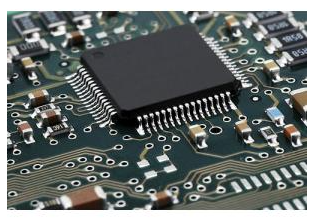PCB processing flow [inner circuit] The copper foil substrate is first cut into a size suitable for processing and production. Before laminating the substrate, it is usually necessary to properly roughen the copper foil on the surface of the board by brushing, microetching, etc., and then attach the dry film photoresist tightly to it at an appropriate temperature and pressure. The substrate with dry film photoresist is sent to the UV exposure machine for exposure. The photoresist will polymerize after being irradiated by ultraviolet rays in the light-transmitting area of the film, and the circuit image on the film is transferred to the dry film photoresist on the board. . After tearing off the protective film on the film surface, first use sodium carbonate aqueous solution to develop and remove the unlit area on the film surface, and then use the hydrogen peroxide mixed solution to corrode and remove the exposed copper foil to form a circuit. Finally, the dry film photoresist that has worked well is washed away with a lightly oxidized sodium water solution.
【Pressing】The inner circuit board must be bonded with the copper foil of the outer circuit with glass fiber resin film. Before pressing, the inner layer board needs to be blackened (oxidized) to passivate the copper surface to increase the insulation; and the copper surface of the inner layer circuit is roughened in order to produce good adhesion to the film. When stacking, first riveting the inner circuit boards of six layers (including) with a riveting machine in pairs. Then use a tray to neatly stack them between the mirror steel plates, and send them to a vacuum laminator to harden and bond the film with proper temperature and pressure. After pressing the circuit board, the target hole is drilled by the X-ray automatic positioning target drilling machine as the reference hole for the alignment of the inner and outer layers. And make appropriate fine cutting of the edge of the board to facilitate subsequent processing
【Drilling】The circuit board is drilled with a CNC drilling machine to drill the conduction channels of the interlayer circuit and the fixing holes of the welding parts. When drilling, use the pin to fix the circuit board on the drilling machine table through the previously drilled target hole, and add a flat bottom plate (phenolic resin board or wood pulp board) and upper cover plate (aluminum plate) at the same time To reduce the occurrence of drilling hair
【Plating through holes】After forming the interlayer vias, a metal copper layer needs to be laid on it to complete the interlayer circuit conduction. First, use heavy brushing and high-pressure washing to clean the hair on the hole and the dust in the hole, and soak the tin on the cleaned hole wall.

【One-time copper】Palladium colloidal layer, which is then reduced to metallic palladium. The circuit board is immersed in a chemical copper solution, and the copper ions in the solution are reduced and deposited on the hole wall by the catalytic action of palladium metal to form a through-hole circuit. Then, the copper layer in the via hole is thickened by copper sulfate bath electroplating to a thickness sufficient to resist the impact of subsequent processing and use environment.
[Outer circuit secondary copper] The production of the circuit image transfer is like the inner circuit, but the circuit etching is divided into two production methods, positive film and negative film. The production method of the negative film is the same as the production of the inner layer circuit. After the development, the copper is directly etched and the film is removed. The production method of the positive film is to add copper and tin-lead twice after development (the tin-lead in this area will be retained as an etching resist in the later copper etching step), and after removing the film, use alkaline The mixed solution of ammonia water and copper chloride corrodes and removes the exposed copper foil to form a circuit. Finally, the tin-lead stripping solution is used to strip the tin-lead layer that has worked out (in the early days, the tin-lead layer was retained and used to coat the circuit as a protective layer after re-wrapping, but it is mostly not used now).
PCB circuit board processing flow [Solder Resistant Ink Text Printing] The earlier green paint was produced by direct thermal drying (or ultraviolet irradiation) after screen printing to harden the paint film. However, because it often causes the green paint to penetrate the copper surface of the circuit terminal contact during the printing and hardening process, which causes problems in welding and use of parts, now in addition to the use of simple and rough circuit boards, photosensitive green paint is often used. in production.